- Calendar
- Online Ticket Sales
- Access
- JA
- EN
Seven Daring Years: Odano Naotake and Akita Ranga
November 16, 2016, to January 9, 2017
*There will be an exhibition change during the course of exhibition.
*Download the list of changes in works on display.
The list of changes in worksPDF
Section 1: The Eve of Ranga
Odano Naotake was born in 1749 to the Odano family, which had samurai rank, in Kakunodate, in the Akita domain. Kakunodate was a branch castle town governed by the Satake Kitake, a branch of the Satake, the daimyo clan who ruled the Akita domain. Naotake’s status was thus a samurai attached to the main Satake clan but directly serving the Satake Kitake in Kakunodate.
Satake Yoshimi, the six-generation castellan of Kakunodate, was born in the same year as Naotake. Satake Shozan, the eighth-generation Akita daimyo, was born the previous year (1748) in the Akita domain’s residence in Edo. Thus, the three principal Akita Ranga artists were very close in age.
Naotake, who learned painting as refined accomplishments appropriate for a samurai, demonstrated his artistic talent at an early age. He studied Kano school painting with an artist by appointment to the Akita domain and also had access to other types of paintings, including works in the ukiyo-e style, and appears to have mastered painting in a wide range of genres.
Section 2: The Kaitai Shinsho Period:
Encounter with Unknown Terrain
In 1773, Hiraga Gennai, an herbalist and entrepreneur who applied his diverse talents in fields ranging from natural history to popular fiction and was also an inventor of note, was invited to the Akita domain in 1773 to develop a mine there. His visit was a major turning point in Naotake’s life. Immediately after Gennai returned to Edo, Naotake was ordered by the domain to follow Gennai to Edo and was assigned to work for Gennai, nominally as the domain’s “copper mining product liaison.”
Gennai had built a large network of talented people who played central roles in Edo culture. Among them were rangakusha, scholars engaged in rangaku, “Dutch studies,” researching Western scholarship and culture. Naotake, who met those rangakusha through Gennai, was selected by Sugita Genpaku and other scholars in 1774 to draw the illustrations for the Kaitai shinsho(New book of anatomy), the first translation into Japanese of a Western medical textbook. The Kaitai shinsho was published eight months after Naotake moved to Edo.
Naotake learned single-point perspective, chiaroscuro, and other techniques used in Western paintings from the illustrations in Western books owned by Gennai and other rangakusha. In this section, we explore, through rangaku and the European imagery Naotake encountered, the world of Western-style painting that was one of the sources of Akita Ranga.
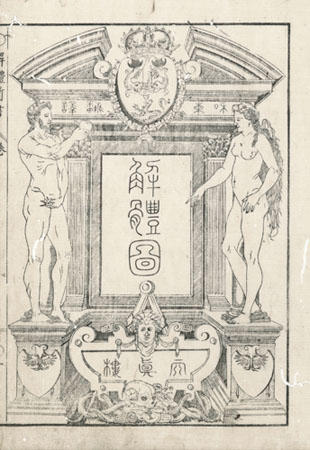
Translation by Sugita Genpaku et al.; illustrations by Odano Naotake
Woodblock printed book; one of five volumes; Edo period (1774)
Tokyo Medical and Dental University Library
Section 3: A New Wave from the Continent:
The Nanpin School in Edo and Akita
In 1731, the Chinese artist Shen Nanping (Japanese: Shin Nanpin) arrived in Nagasaki and introduced a new style of bird-and-flower painting, which had an enormous impact on the art world in Japan. A realistic yet decorative style of painting, rich in auspicious motifs, swiftly spread throughout Japan, where it was known as the Nanpin school.
Naotake was residing in Edo precisely during the period when the Nanpin school had become very fashionable. Gennai’s network included So Shiseki, who disseminated Nanpin-style bird-and-flower painting in Edo, and Naotake was evidently influenced by him. Because of similarities in subjects and compositions, the Nanpin school is regarded, along with Western-style painting, as being one of the origins of Akita Ranga painting
The fascination with the Nanpin school reached artists from the Akita domain as well. Sasaki Harazen, whose patrons were Tomura Yoshitaka, castellan of the Akita domain’s Yokote branch castle, and his son Yoshimichi, studied Nanpin school painting with Shorin Sanjin, who was active in Edo in the 1770s. Harazen also is said to have studied in Nagasaki.
This section presents the world of Chinese painting, one of the sources of Akita Ranga, through works of Nanpin-school artists active in Edo and Akita.
Section 4: The Trajectory of Akita Ranga
Naotake, exploring both Chinese and Occidental art, learned from both European illustrations and Nanpin-style bird-and-flower paintings. Integrating both Eastern and Western art in his work, he created what we know today as Akita Ranga. The new style he devised spread to others in Naotake’s circle, including Satake Shozan, the Akita daimyo and a passionate student of natural history, Satake Yoshimi, the Kakunodate castellan, who appreciated and supported what Naotake was doing, and Tashiro Tadakuni, another Akita domain samurai.
It is thought that when Naotake returned home in 1777, he brought Western-style techniques to Akita. Satake Shozan then wrote Japan’s first treatises on Western-style painting, the Gaho koryo(Summary of the laws of painting) and the Gato rikai(Understanding of painting) in 1778. In the same year, Naotake was assigned to serve the Akita domain directly and was removed from the contingent of samurai serving the Kitake branch of the Satake family. He then returned to Edo, accompanying Satake Shozan for the period of residence in Edo required by the alternate residence system.
The Akita Ranga paintings that Naotake and his colleagues created are fresh and full of surprises today: strange spaces with the foreground radically enlarged and the background rendered with great depth, naturalistic depictions of peonies, lotuses, and other beautiful flowers, and realistic depictions of the human figure.
This section brings together Akita Ranga paintings that epitomize the superb artistic talents of Odano Naotake, Satake Shozan, and their colleagues, to explore their achievements.
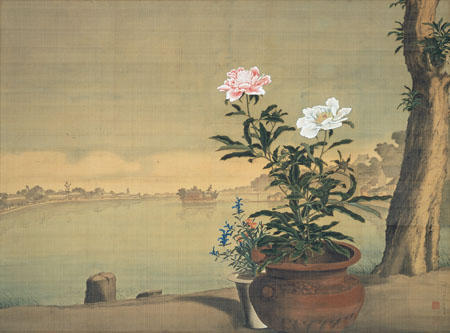
Shinobazu Pond
Odano Naotake; Color on silk; one framed painting; Edo period (18th century)
Akita Museum of Modern Art
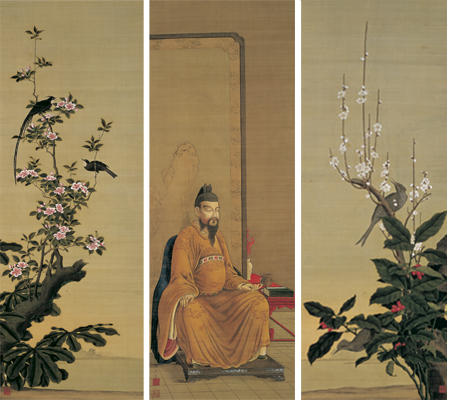
Emperor Taizong of the Tang, Bird and Flower, and Landscape
Odano Naotake; Color on silk; hanging scroll triptych
Edo period (18th century)
Akita Museum of Modern Art
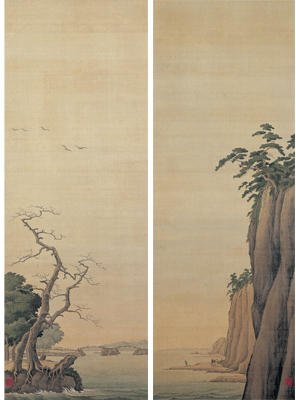
Japanese Landscapes
Odano Naotake; Color on silk; hanging scroll diptych
Edo period (18th century)
Shogenji, Mie
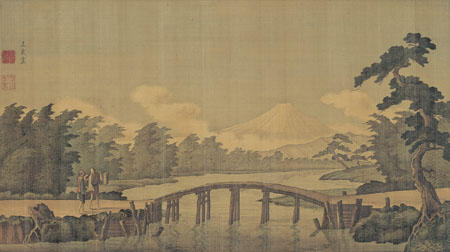
Mt. Fuji
Odano Naotake; Color on silk; hanging scroll diptych; Edo period (18th century)
Akita Museum of Modern Art

Odano Naotake
Color on silk; hanging scroll
Edo period (18th century)
Kobe City Museum

Pine Tree and Parrot
Satake Shozan; Color on silk
hanging scroll
Edo period (18th century)
Private collection
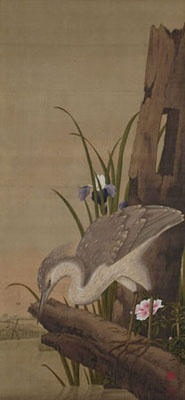
Odano Naotake
Color on silk; hanging scroll
Edo period (18th century)
Kikuan
Section 5: Akita Ranga’s Continuing Influence
In 1779, the Akita domain suddenly ordered Naotake to return to Kakunodate and be placed under house arrest. Hiraga Gennai had been arrested for murder at about that time; he then died in prison. In 1780, Naotake’s life came to an end at the age of 30. The reason for his house arrest and the cause of his death remain a mystery. Satake Shozan died not long after, in 1785.
With the deaths of the seminal figures Gennai, Naotake, and Shozan, Akita Ranga could not continue as a school of painting. Its influence did not, however, disappear entirely. Shiba Kokan, who played an active role as a Western-style painter, is believed to have studied with him and to have carried on his innovations. Kokan, who was also part of Gennai’s circle of artists and rangaku scholars, went on to create new genres in Japanese art, including copperplate prints and oil paintings.
After the deaths of Naotake and Shozan, Akita Ranga was gradually forgotten. It was, however, rediscovered in the twentieth century. Most notably, the publication in 1930 of Nihon yoga shoko(The dawn of Western-style painting in Japan) by Hirafuku Hyakusui, a Nihonga artist who also a native of Akita, cast new light on Akita Ranga.
This section explores the continuing influence of Akita Ranga, largely through Edo-period Western-style paintings by Shiba Kokan and other artists.
*Unauthorized reproduction or use of texts or images from this site is prohibited.
2024 January
- Exhibition
- Closed
- Tea Ceremony
- Mon
- Tue
- Wed
- Thu
- Fri
- Sat
- Sun
- 1
- 2
- 3
- 4
- 5
- 6
- 7
- 8
- 9
- 10
- 11
- 12
- 13
- 14
- 15
- 16
- 17
- 18
- 19
- 20
- 21
- 22
- 23
- 24
- 25
- 26
- 27
- 28
- 29
- 30
- 31
2024 February
- Exhibition
- Closed
- Tea Ceremony
- Mon
- Tue
- Wed
- Thu
- Fri
- Sat
- Sun
- 1
- 2
- 3
- 4
- 5
- 6
- 7
- 8
- 9
- 10
- 11
- 12
- 13
- 14
- 15
- 16
- 17
- 18
- 19
- 20
- 21
- 22
- 23
- 24
- 25
- 26
- 27
- 28
- 29
2024 March
- Exhibition
- Closed
- Tea Ceremony
- Mon
- Tue
- Wed
- Thu
- Fri
- Sat
- Sun
- 1
- 2
- 3
- 4
- 5
- 6
- 7
- 8
- 9
- 10
- 11
- 12
- 13
- 14
- 15
- 16
- 17
- 18
- 19
- 20
- 21
- 22
- 23
- 24
- 25
- 26
- 27
- 28
- 29
- 30
- 31
2024 April
- Exhibition
- Closed
- Tea Ceremony
- Mon
- Tue
- Wed
- Thu
- Fri
- Sat
- Sun
- 1
- 2
- 3
- 4
- 5
- 6
- 7
- 8
- 9
- 10
- 11
- 12
- 13
- 14
- 15
- 16
- 17
- 18
- 19
- 20
- 21
- 22
- 23
- 24
- 25
- 26
- 27
- 28
- 29
- 30
2024 May
- Exhibition
- Closed
- Tea Ceremony
- Mon
- Tue
- Wed
- Thu
- Fri
- Sat
- Sun
- 1
- 2
- 3
- 4
- 5
- 6
- 7
- 8
- 9
- 10
- 11
- 12
- 13
- 14
- 15
- 16
- 17
- 18
- 19
- 20
- 21
- 22
- 23
- 24
- 25
- 26
- 27
- 28
- 29
- 30
- 31
2024 June
- Exhibition
- Closed
- Tea Ceremony
- Mon
- Tue
- Wed
- Thu
- Fri
- Sat
- Sun
- 1
- 2
- 3
- 4
- 5
- 6
- 7
- 8
- 9
- 10
- 11
- 12
- 13
- 14
- 15
- 16
- 17
- 18
- 19
- 20
- 21
- 22
- 23
- 24
- 25
- 26
- 27
- 28
- 29
- 30
2024 July
- Exhibition
- Closed
- Tea Ceremony
- Mon
- Tue
- Wed
- Thu
- Fri
- Sat
- Sun
- 1
- 2
- 3
- 4
- 5
- 6
- 7
- 8
- 9
- 10
- 11
- 12
- 13
- 14
- 15
- 16
- 17
- 18
- 19
- 20
- 21
- 22
- 23
- 24
- 25
- 26
- 27
- 28
- 29
- 30
- 31
2024 August
- Exhibition
- Closed
- Tea Ceremony
- Mon
- Tue
- Wed
- Thu
- Fri
- Sat
- Sun
- 1
- 2
- 3
- 4
- 5
- 6
- 7
- 8
- 9
- 10
- 11
- 12
- 13
- 14
- 15
- 16
- 17
- 18
- 19
- 20
- 21
- 22
- 23
- 24
- 25
- 26
- 27
- 28
- 29
- 30
- 31
2024 September
- Exhibition
- Closed
- Tea Ceremony
- Mon
- Tue
- Wed
- Thu
- Fri
- Sat
- Sun
- 1
- 2
- 3
- 4
- 5
- 6
- 7
- 8
- 9
- 10
- 11
- 12
- 13
- 14
- 15
- 16
- 17
- 18
- 19
- 20
- 21
- 22
- 23
- 24
- 25
- 26
- 27
- 28
- 29
- 30
2024 October
- Exhibition
- Closed
- Tea Ceremony
- Mon
- Tue
- Wed
- Thu
- Fri
- Sat
- Sun
- 1
- 2
- 3
- 4
- 5
- 6
- 7
- 8
- 9
- 10
- 11
- 12
- 13
- 14
- 15
- 16
- 17
- 18
- 19
- 20
- 21
- 22
- 23
- 24
- 25
- 26
- 27
- 28
- 29
- 30
- 31
2024 November
- Exhibition
- Closed
- Tea Ceremony
- Mon
- Tue
- Wed
- Thu
- Fri
- Sat
- Sun
- 1
- 2
- 3
- 4
- 5
- 6
- 7
- 8
- 9
- 10
- 11
- 12
- 13
- 14
- 15
- 16
- 17
- 18
- 19
- 20
- 21
- 22
- 23
- 24
- 25
- 26
- 27
- 28
- 29
- 30
2024 December
- Exhibition
- Closed
- Tea Ceremony
- Mon
- Tue
- Wed
- Thu
- Fri
- Sat
- Sun
- 1
- 2
- 3
- 4
- 5
- 6
- 7
- 8
- 9
- 10
- 11
- 12
- 13
- 14
- 15
- 16
- 17
- 18
- 19
- 20
- 21
- 22
- 23
- 24
- 25
- 26
- 27
- 28
- 29
- 30
- 31
2025 January
- Exhibition
- Closed
- Tea Ceremony
- Mon
- Tue
- Wed
- Thu
- Fri
- Sat
- Sun
- 1
- 2
- 3
- 4
- 5
- 6
- 7
- 8
- 9
- 10
- 11
- 12
- 13
- 14
- 15
- 16
- 17
- 18
- 19
- 20
- 21
- 22
- 23
- 24
- 25
- 26
- 27
- 28
- 29
- 30
- 31
2025 February
- Exhibition
- Closed
- Tea Ceremony
- Mon
- Tue
- Wed
- Thu
- Fri
- Sat
- Sun
- 1
- 2
- 3
- 4
- 5
- 6
- 7
- 8
- 9
- 10
- 11
- 12
- 13
- 14
- 15
- 16
- 17
- 18
- 19
- 20
- 21
- 22
- 23
- 24
- 25
- 26
- 27
- 28
2025 March
- Exhibition
- Closed
- Tea Ceremony
- Mon
- Tue
- Wed
- Thu
- Fri
- Sat
- Sun
- 1
- 2
- 3
- 4
- 5
- 6
- 7
- 8
- 9
- 10
- 11
- 12
- 13
- 14
- 15
- 16
- 17
- 18
- 19
- 20
- 21
- 22
- 23
- 24
- 25
- 26
- 27
- 28
- 29
- 30
- 31
2025 April
- Exhibition
- Closed
- Tea Ceremony
- Mon
- Tue
- Wed
- Thu
- Fri
- Sat
- Sun
- 1
- 2
- 3
- 4
- 5
- 6
- 7
- 8
- 9
- 10
- 11
- 12
- 13
- 14
- 15
- 16
- 17
- 18
- 19
- 20
- 21
- 22
- 23
- 24
- 25
- 26
- 27
- 28
- 29
- 30
2025 May
- Exhibition
- Closed
- Tea Ceremony
- Mon
- Tue
- Wed
- Thu
- Fri
- Sat
- Sun
- 1
- 2
- 3
- 4
- 5
- 6
- 7
- 8
- 9
- 10
- 11
- 12
- 13
- 14
- 15
- 16
- 17
- 18
- 19
- 20
- 21
- 22
- 23
- 24
- 25
- 26
- 27
- 28
- 29
- 30
- 31
2025 June
- Exhibition
- Closed
- Tea Ceremony
- Mon
- Tue
- Wed
- Thu
- Fri
- Sat
- Sun
- 1
- 2
- 3
- 4
- 5
- 6
- 7
- 8
- 9
- 10
- 11
- 12
- 13
- 14
- 15
- 16
- 17
- 18
- 19
- 20
- 21
- 22
- 23
- 24
- 25
- 26
- 27
- 28
- 29
- 30
2025 July
- Exhibition
- Closed
- Tea Ceremony
- Mon
- Tue
- Wed
- Thu
- Fri
- Sat
- Sun
- 1
- 2
- 3
- 4
- 5
- 6
- 7
- 8
- 9
- 10
- 11
- 12
- 13
- 14
- 15
- 16
- 17
- 18
- 19
- 20
- 21
- 22
- 23
- 24
- 25
- 26
- 27
- 28
- 29
- 30
- 31
2025 August
- Exhibition
- Closed
- Tea Ceremony
- Mon
- Tue
- Wed
- Thu
- Fri
- Sat
- Sun
- 1
- 2
- 3
- 4
- 5
- 6
- 7
- 8
- 9
- 10
- 11
- 12
- 13
- 14
- 15
- 16
- 17
- 18
- 19
- 20
- 21
- 22
- 23
- 24
- 25
- 26
- 27
- 28
- 29
- 30
- 31
2025 September
- Exhibition
- Closed
- Tea Ceremony
- Mon
- Tue
- Wed
- Thu
- Fri
- Sat
- Sun
- 1
- 2
- 3
- 4
- 5
- 6
- 7
- 8
- 9
- 10
- 11
- 12
- 13
- 14
- 15
- 16
- 17
- 18
- 19
- 20
- 21
- 22
- 23
- 24
- 25
- 26
- 27
- 28
- 29
- 30
2025 October
- Exhibition
- Closed
- Tea Ceremony
- Mon
- Tue
- Wed
- Thu
- Fri
- Sat
- Sun
- 1
- 2
- 3
- 4
- 5
- 6
- 7
- 8
- 9
- 10
- 11
- 12
- 13
- 14
- 15
- 16
- 17
- 18
- 19
- 20
- 21
- 22
- 23
- 24
- 25
- 26
- 27
- 28
- 29
- 30
- 31
2025 November
- Exhibition
- Closed
- Tea Ceremony
- Mon
- Tue
- Wed
- Thu
- Fri
- Sat
- Sun
- 1
- 2
- 3
- 4
- 5
- 6
- 7
- 8
- 9
- 10
- 11
- 12
- 13
- 14
- 15
- 16
- 17
- 18
- 19
- 20
- 21
- 22
- 23
- 24
- 25
- 26
- 27
- 28
- 29
- 30
2025 December
- Exhibition
- Closed
- Tea Ceremony
- Mon
- Tue
- Wed
- Thu
- Fri
- Sat
- Sun
- 1
- 2
- 3
- 4
- 5
- 6
- 7
- 8
- 9
- 10
- 11
- 12
- 13
- 14
- 15
- 16
- 17
- 18
- 19
- 20
- 21
- 22
- 23
- 24
- 25
- 26
- 27
- 28
- 29
- 30
- 31
